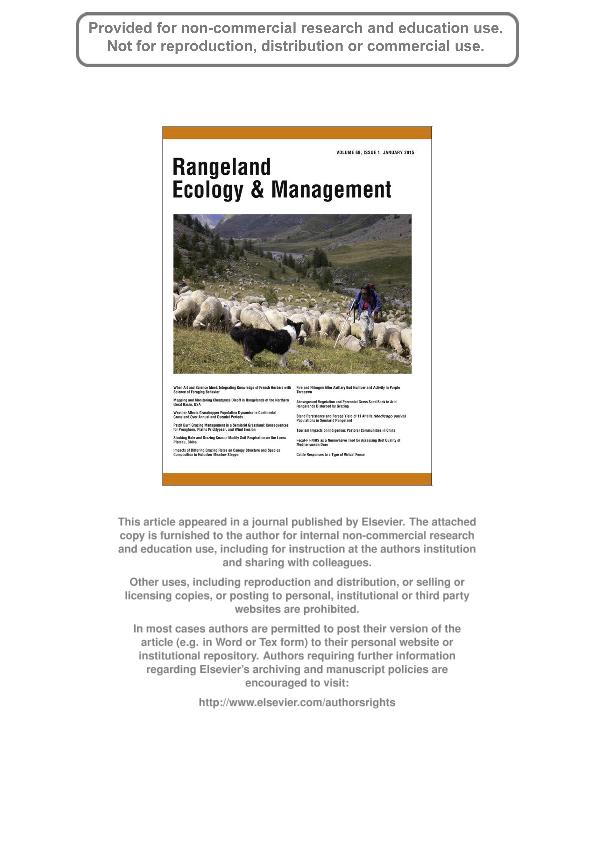Mostrar el registro sencillo del ítem
dc.contributor.author
Bertiller, Monica Beatriz

dc.contributor.author
Carrera, Analía Lorena

dc.date.available
2017-05-22T21:33:07Z
dc.date.issued
2015
dc.identifier.citation
Bertiller, Monica Beatriz; Carrera, Analía Lorena; Aboveground vegetation and perennial grass seed bank in arid rangelands disturbed by grazing; Elsevier; Rangeland Ecology And Management; 68; 1; -1-2015; 71-78
dc.identifier.issn
1550-7424
dc.identifier.uri
http://hdl.handle.net/11336/16841
dc.description.abstract
Recruitment by seeds can be an important mechanism for recovery of plant communities following disturbance. Our objective was to assess the density and spatial patterning of perennial grass (highly preferred by herbivores) seeds in litter patches at locations with different aboveground vegetation structure in sites with different grazing history characteristic of the Patagonian Monte (Argentina). We asked whether structural differences in aboveground vegetation are reflected in the density and spatial patterning of perennial grass seeds in litter patches. We selected two study sites characteristic of the Patagonian Monte and within them three locations representing different vegetation states, resulting from different combinations of grazing and/or release from grazing history. At each location, we assessed the density of perennial grass seeds in litter patches at microsites beneath plant patches (canopy) and in interpatch areas without or with scattered vegetation (bare soil) at three dates during the reproductive and seed dispersal periods. The density of perennial grass seeds in litter patches was greater at canopy than at bare soil microsites, and the number of litter patches without seeds increased with decreasing total plant cover at both microsites. The density of perennial grass seeds in litter patches did not vary with differences in total plant cover or litter patch attributes at canopy microsites, while it was reduced with decreasing total plant cover at bare soil microsites. We concluded that differences in aboveground plant cover differentially affected the density of perennial grass seeds in litter patches at contrasting soil microsites. Thus potential microsites for perennial grass recruitment by seeds would increase from litter patches at bare soil microsites to litter patches at canopy microsites at locations with high and low aboveground plant cover, respectively. These issues should be considered for the sustainable management of these rangelands.
dc.format
application/pdf
dc.language.iso
eng
dc.publisher
Elsevier

dc.rights
info:eu-repo/semantics/openAccess
dc.rights.uri
https://creativecommons.org/licenses/by-nc-nd/2.5/ar/
dc.subject
Litter Patch
dc.subject
Patagonian Monte
dc.subject
Patterning of Seed Bank
dc.subject
Plant Patch
dc.subject
Spatial Vegetation States
dc.subject.classification
Otras Ciencias Agrícolas

dc.subject.classification
Otras Ciencias Agrícolas

dc.subject.classification
CIENCIAS AGRÍCOLAS

dc.title
Aboveground vegetation and perennial grass seed bank in arid rangelands disturbed by grazing
dc.type
info:eu-repo/semantics/article
dc.type
info:ar-repo/semantics/artículo
dc.type
info:eu-repo/semantics/publishedVersion
dc.date.updated
2016-11-23T19:42:04Z
dc.identifier.eissn
1551-5028
dc.journal.volume
68
dc.journal.number
1
dc.journal.pagination
71-78
dc.journal.pais
Países Bajos

dc.journal.ciudad
Amsterdam
dc.description.fil
Fil: Bertiller, Monica Beatriz. Consejo Nacional de Investigaciones Científicas y Técnicas. Centro Nacional Patagónico; Argentina. Universidad Nacional de la Patagonia; Argentina
dc.description.fil
Fil: Carrera, Analía Lorena. Consejo Nacional de Investigaciones Científicas y Técnicas. Centro Nacional Patagónico; Argentina. Universidad Nacional de la Patagonia; Argentina
dc.journal.title
Rangeland Ecology And Management

dc.relation.alternativeid
info:eu-repo/semantics/altIdentifier/doi/http://dx.doi.org/10.1016/j.rama.2014.12.008
dc.relation.alternativeid
info:eu-repo/semantics/altIdentifier/url/http://www.sciencedirect.com/science/article/pii/S1550742414000098
Archivos asociados
